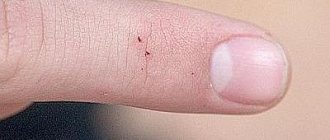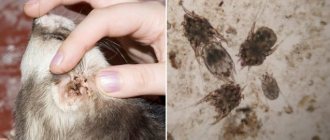Veronica Igorevna Sharipova
veterinarian Petstory
Demodectic mange in cats is a fairly rare parasitic disease. The cause of the disease is two types of ticks - Demodex gatoi and Demodex cati, and each of them has its own characteristics. The disease can be focal (single areas of damage) or generalized (extensive).
The first article mentioning the presence of demodicosis in cats was published relatively recently - in 1982. At the moment, the disease is not typical for Russia and is extremely rare.
Demodicosis in cats - basic information
- Rare parasitic disease of cats;
- Currently, two species of mites have been described - Demodex gatoi and Demodex cati, the characteristics of which are significantly different;
- The main symptoms of demodicosis: itching, areas of baldness, severe anxiety;
- Diagnosis is made by microscopy;
- The most modern method of treatment is the use of drops on the withers based on fluralaner;
- Prevention consists of avoiding overcrowding of animals and compliance with zoohygienic standards for their maintenance.
Features of ticks
There are more than 140 species of parasites that infect living organisms with demodicosis. A cat becomes infected with a separate type of tick that does not parasitize another animal or person.
The tick that infects a cat, in turn, comes in two types:
- Demodex gatoi – parasitizes the skin;
- Demodex cati - affects the hair follicle.
The tick is very small and impossible to notice. Length – only 0.5 mm. It is elongated and almost transparent. Within 3 weeks, the tick develops and becomes a sexually mature individual. The life cycle of the parasite is up to 5 weeks. A favorable condition for reproduction is blockage of the sebaceous gland.
The danger of a tick is that it can penetrate internal organs through the lymphatic system and cause the appearance of affected areas throughout the body, even involving the paws.
Places where ticks often parasitize:
- neck;
- head;
- ears.
Symptoms
Symptoms of demodicosis in cats can vary. With focal (localized) lesions, itchy otitis media or areas of baldness with redness of the skin may be observed, which may then become covered with dry crusts. Most often, focal lesions occur around the eyes, on the head and neck. With a generalized lesion, itching varies from severe (with Demodex gatoi disease) to mild (with Demodex cati disease). At the same time, extensive areas of baldness are noted, which often cover the entire body of the cat.
It is worth noting that Demodex gatoi is highly contagious to other cats, and Demodex cati is associated with a state of severe immunosuppression in the cat (due to the presence of viral immunodeficiency in the cat, a malignant tumor, and the use of hormonal drugs) and is not transmitted to other cats.
Prevention
- Avoid contact between a healthy cat and a cat with demodicosis.
- Timely detection of the disease and contact a specialist.
- Timely preventive treatment of cats against ectoparasites that live on the animal’s skin.
- Treating premises, cages, and places of residence of cats infected or suspected of demodicosis with acaricidal preparations, the action of which is directed against ticks.
- It is recommended to destroy bedding, feeders, equipment (rags, brushes, etc.) from a sick animal.
Diagnostics
Demodectic mange in cats must be distinguished from diseases such as dermatophytosis (fungal skin infection), bacterial folliculitis, food allergies, allergic flea dermatitis, psychogenic alopecia, contact dermatitis, atopic dermatitis and other types of tick-borne infections.
The main method of diagnosis, given the miniature size of this mite, is microscopy. To identify demodicosis in cats, multiple deep and superficial scrapings are taken. Unfortunately, given that a cat can ingest parasites during grooming, they cannot always be detected in scrapings. In such cases, you can try to find the tick in feces using the flotation method. Also, if a disease is suspected, but test results are negative, it is advisable to conduct a trial treatment.
It is possible to determine the specific type of demodicosis in a cat only by microscopy, since different types of mites differ significantly in appearance.
Hurry up, choose a box and find out what gift awaits you
Discount on pet insurance
Promo code copied to clipboard
Symptoms of Demodex infection
Experts from veterinary medicine claim that the entire cat tribe is carriers of the tick, but most animals have an asymptomatic stage, the first stage of the disease.
In the vast majority of domestic couch potatoes, it remains inactive until the end of their lives, because loving owners simply do not allow favorable conditions for the development of demodicosis to arise: their pets are always healthy, well-fed, strong and have a stable immune system. However, certain breeds of even very well-groomed animals have an increased risk of getting sick. These are Siamese and Burmese pussies. Also at risk are young individuals and animals suffering from internal parasites. And of course, no one has yet canceled genetic predisposition.
An attentive owner will not miss the onset of the disease in his mustachioed friend if the tick suddenly goes into an active, local phase and begins an attack:
- Small, coin-sized, dark areas on the skin surface will appear around the nose and mouth.
- The epithelium thickens, cracks, and scratches and scabs form.
- Baldness begins in the affected areas (around the eyes, nose, mouth, ears, paws and neck). Characteristic “demodectic glasses” are formed.
- Papules are formed, from which, when squeezed out, ichor and a wax-like secretion flow out, and mites come out with it.
- Abscesses and shiny redness around indicate an infection.
- The fur becomes disheveled and unkempt, as if moths had worked hard on it.
- Itching of the skin is practically absent, since the subcutaneous mite does not move.
- The pet has a weakened, emaciated appearance.
Treatment
- When dealing with Demodex gatoi infestation, it is important to treat all cats in contact, even if they do not show clinical signs of the disease.
- Previously, the main method of treating demodicosis in cats was treating the animals with a solution of 2% lime sulfur (lime sulfur). But such treatment is quite difficult for cats, and the solution itself smells very unpleasant.
- The use of injectable forms of ivermectin is effective (only a veterinarian can select the course and dosage!).
- It is quite effective to treat demodicosis in a cat by applying moxidectin-based drops to the withers once a week, a total of 10 treatments are required.
- The most modern and safe treatment for demodicosis in cats is the use of fluralaner-based drops on the withers.
Environmental treatment for this disease is not important, since this parasite does not survive long outside the animal’s body.
Main reasons
Cats of all ages and any breed are susceptible to demodicosis, but most often demodicosis is diagnosed in old and weakened animals. Scientists have not fully studied the main causes of the disease, but most experts agree that the main factors for infection with demodicosis are the following:
- genetic predisposition;
- presence of helminthic infestations;
- poor care of the animal's fur and skin;
- unbalanced cat nutrition.
The main reason for the development of the disease is considered to be a decrease in the cat’s immunity, as a result of which the tick takes a pathogenic form and begins to actively multiply in the epidermis of the animal. Very often the disease is registered in small kittens after weaning them from their mother.
For a healthy person, demodicosis is completely safe. Despite the fact that people also suffer from demodicosis, the tick that parasitizes the animal’s body does not pose a threat to humans.
In humans, demodicosis is caused by a completely different type of parasite. Despite this, some people (especially those with weakened immune systems) may want to avoid contact with a sick cat.
A healthy cat can become infected with demodicosis through contact with a sick relative; in addition, there are known cases of intrauterine transmission of the disease, from mother cats to kittens.
Read more about demodicosis in animals in the Veterinary Directory.
Find out more about other types of mites on cats >>>
Diagnosis and treatment
In a number of external manifestations, demodicosis can be similar to skin dermatitis and ringworm.
Therefore, in addition to an external examination, the doctor will definitely prescribe laboratory diagnostics for an accurate diagnosis and prescribe subsequent treatment. To do this, using a scalpel, a deep scraping is taken from the skin in several places and examined under a microscope. When confirming the diagnosis, specialists identify a certain number of tick individuals at different stages of their development (egg, larva, nymph, adult). When a diagnosis is refuted, that is, a safe carriage, specialists detect only adult individuals or their complete absence. Demodicosis can be treated quite well if the treatment regimen is correctly selected by the doctor and timely contact with him. Advanced forms will have to be treated for a long time: from several weeks to a year. It is advisable not to let this happen, nor to self-medicate using traditional methods, but it is better to immediately consult a doctor without wasting precious time. Treatment will be effective only with a combined approach of a set of measures in the fight against ticks and the targeted restoration of the health and immunity of the animal.
Usually the doctor prescribes the following set of medications:
- Antiparasitic injections of the ivermectin series under the skin, observing the exact dosage: Amirtrazin, Ivermectin, Baymecom, Eprimek, Otodectin, Ivomek, Novomek, Aaversect, Dectomax, Cydectin, etc.
- External solutions of drugs Stomazan, Butox, etc.
- Immunoparasite. Very effective. The drug helps to increase the body's resistance to parasites, activating its protective functions and protects against their re-introduction. In addition to this drug, Gamavit, Gala-vet, Immunol, Maxidin, etc. are also effective.
- To relieve skin inflammation, anti-inflammatory and special topical agents are prescribed in the form of ointments, gels (sulfur ointment, Pikhtoin, sea buckthorn oil, Demos liniment, Amidel gel, Ivermect gel, Aversectin ointment, Saphroderm ointment, Cythioate ointment, etc.). A greater effect is achieved after bathing and cleansing the skin of crusts.
- External special sprays of Acaromectin, Ivermectin, Cydem, Pirol, etc. Or irrigate and lubricate the affected areas with a pre-diluted solution of Neostomazan, according to the instructions.
- Use oil preparations Mycodemicil, Tsipam, Ectodex, Amit, etc. to treat bald spots with scabs. You can use simple oils: sea buckthorn, flaxseed, olive. Oils are very effective for this disease. It is necessary that they are absorbed into the skin, and the cat should not be allowed to lick them. She can be wrapped up. Only after the oil has been completely absorbed should external preparations be used as prescribed by the doctor.
- Skin application of Stronghold or Advocate once a month between the shoulder blades. A course of 2-4 months.
- Vitamins, minerals and microelements (Vitam, etc.).
- If a secondary bacterial infection is detected, the course will have to include antibiotics (Ammoxicillin, Kanamycin, Baytril, Betamox, etc.).
- A cat with demodicosis should be bathed using special shampoos “Doctor” with benzoyl peroxide, “Elite” with chlorhexidine in order to clean the surface of the animal’s skin.
- Treat the skin with solutions of hydrogen peroxide or chlorhexidine. This measure will clear it of scabs, ulcers and crusts. Subsequently, gently and thoroughly blot and dry the skin. Thus preparing for the application of the above-described drugs.
In addition to medications, the owner must provide his pet with a complete diet rich in protein, vitamins, and minerals. Improving living conditions also plays an important role: wash and boil all grooming equipment, bedding, comb, plates, toys, litter tray. You can simply disinfect them in disinfectant solutions and then rinse them well. Use an iron with hot steam over the surface of the sofas, frequently carry out wet cleaning with disinfectants, and temporarily remove carpets. If there are other cats in the house, they also need to be diagnosed and treated.
Therapy should be carried out only under the supervision of a physician. Treatment can be considered complete only when the results of two repeated laboratory examinations of scrapings give a negative result.
The owner, among other things, should not forget about preventive measures in the future in order to avoid a relapse. And at the first suspicion, immediately contact the veterinary clinic.
Preventive measures
In order to avoid symptoms and treatment of subcutaneous mites in cats in the future, it is necessary to take care of prevention in advance. First of all, regularly treat the animal with antiparasitic drugs (for fleas and ticks), check for worms and monitor the balance of the pet’s diet. A cat's diet should be rich in all necessary vitamins and microelements.
You should not allow your pet near animals whose health status is in doubt. It’s better to play it safe than to later discover demodicosis in your cat. Also try to maintain your pet’s immunity; your veterinarian will prescribe the necessary medications.
Although today there are many medicines for the treatment of subcutaneous mites, it is better not to deal with this disease. And not even because a lot of time passes from diagnosis to recovery. First of all, the cat suffers, for which demodicosis brings a lot of discomfort. And if you take preventative measures, your pet will always be healthy.
You can now see the current price of anti-tick medications and buy them right here:
Measures to prevent demodicosis
To maintain the strength of your immune system, and therefore prevent the development of the disease, you just need to follow simple rules:
- Provide adequate nutrition.
- Carry out deworming regularly.
- Do not use antibacterial agents uncontrollably.
- Keep cat supplies (toilet, dishes, toys, bedding, etc.) clean.
- Minimize contact with sick and homeless animals.
And then the parasite living in your pet’s body will never take over his health and appearance.
Treatment and prevention
The essence of all therapeutic measures comes down to the total elimination of demodex mites. Symptomatic treatment alone will not lead to the desired result. The therapy is complex, the veterinarian selects external and internal remedies according to the results of the study and the degree of neglect of the disease. They use ointments, oral medications, and injections.
Be sure to increase immunity, treat diseases, eliminate conditions that can worsen the functioning of the immune system. Be sure to eat a balanced diet of vitamins and proteins.
All treatment measures end only after two negative scrapings, which are done with an interval of 30 days.
What should the owner do:
- completely eliminate contact between a sick and healthy cat;
- be sure to consult a veterinarian;
- promptly treat against ectoparasites;
- all bedding, equipment, etc. are destroyed.
If you notice that redness, pimples, inflammation have appeared on your cat’s skin, the animal is worried and scratches heavily around the ears, muzzle, etc. – don’t hesitate! Call urgently, 24 hours a day, the RosVet Exhibition Center receives visitors 24 hours a day.
Causes
Feline demodicosis is a consequence of decreased immunity. But other factors can also trigger the disease:
- genetic predisposition;
- helminth infection;
- poor quality food;
- lack of vitamins B, A and E;
- keeping in inappropriate conditions.
Important!
The cat tick is found on the body of every animal and is classified as an opportunistic parasite. And only the creation of favorable conditions will provoke their growth.











